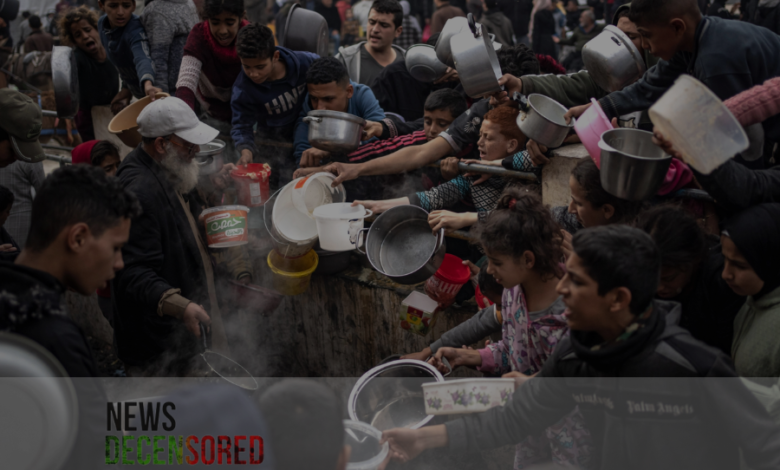New report warns famine is ‘likely’ already affecting northern Gaza

ROME – Famine is imminent in the northern Gaza Strip, and the entire population of Gaza faces crisis levels or worse of food insecurity, according to the Integrated Interim Classification of Food Security report released today.
About 300,000 people remain trapped in northern Gaza, where famine is expected to occur anytime between today and May. Acute food insecurity has well exceeded the famine threshold, while acute malnutrition among children under five is heading at record speed towards the second famine threshold. At the same time, non-trauma deaths – the ultimate indicator of famine – are accelerating but data remain limited, as is the case in war zones.
The new report shows that 1.1 million people in Gaza – half the population – have completely exhausted their food supplies and coping capacities, and are suffering from catastrophic hunger (IPC Phase 5) and death from starvation. This is the largest number ever recorded by the classification of people facing catastrophic hunger, and double the number of people who were in the fifth phase of the classification just three months ago.
People in Gaza are now starving to death,” says WFP Executive Director Cindy McCain. “The speed with which the man-made hunger and malnutrition crisis has spread in Gaza is terrifying. There is only a very limited window of opportunity left to stave off certain famine, and to do so “We need immediate and full access to the north. If we wait until famine is declared, it will be too late, after thousands more will die.”
The report noted that malnutrition is rapidly increasing throughout the Gaza Strip, where the acute malnutrition rate was less than 1% before the fighting escalated five months ago. In North Gaza Governorate, the latest data suggests that one in three children under the age of two now suffer from severe malnutrition or “wasting”, meaning they are dangerously thin for their height, putting them at risk of death.
The southern governorates of Deir al-Balah, Khan Yunis, and Rafah are classified in IPC Phase 4 (Emergency), and are also at risk of sliding into famine conditions by July 2024; 88% of Gaza’s population faces emergency or worse food security conditions. “Across Gaza, women and children are only one illness, one forced transfer or another catastrophic event away from losing hope and losing everything,” says WFP Executive Director Cindy McCain.
The report said that famine could still be avoided – even in northern Gaza – if full access was granted to relief organizations to provide food, water, nutritional products, medicines, health and sanitation services, on a large scale, to the entire civilian population. For this to be possible, a humanitarian ceasefire is necessary.
The World Food Program estimates that just meeting basic food needs will require at least 300 trucks entering Gaza daily to distribute food, especially in the north. The World Food Program has only been able to deliver nine convoys to the north since the beginning of the year.
On Sunday evening, the last of these convoys arrived in Gaza City, including 18 trucks loaded with food supplies delivered by the World Food Programme. It is the second convoy to use a new land route to Gaza City and the northern Gaza Strip, and delivered about 274 metric tons of wheat flour, food baskets, and ready-to-eat food rations. This road must be made available for daily convoys and safe access to the north.
Sending aid to northern Gaza requires daily approvals from the Israeli authorities. During long waits at the checkpoint, convoys are looted and often turned back. If the trucks make it through, there is the potential for more looting along the difficult route to the north.
WFP and our partners have ready food supplies, at the border and in the region, to feed 2.2 million people across Gaza, but transporting food to Gaza is like trying to navigate a maze,” says WFP Deputy Executive Director and Director of Operations, Karl Skau. , with obstacles at every turn.
Complex border controls, coupled with extreme tension and lack of hope inside Gaza, make it almost impossible for food supplies to reach those in need, especially in the north, but the delivery of 18 trucks of food on Sunday shows that it can be done. This cannot be a single event, but must be sustained, regular and on a large scale to support those in need.
To provide the necessary response, WFP and its humanitarian partners need Israel to provide more entry points into Gaza, direct access through crossings in the north, and to use the port of Ashdod in Israel to bring in food aid.
Continued ground access – both into Gaza and beyond – is crucial; Because other options, such as airdrops, cannot deliver the amount of aid urgently needed to avert imminent famine. Above all, a ceasefire is urgently needed so that WFP and the humanitarian community can launch a massive relief operation that reaches all communities in need.




